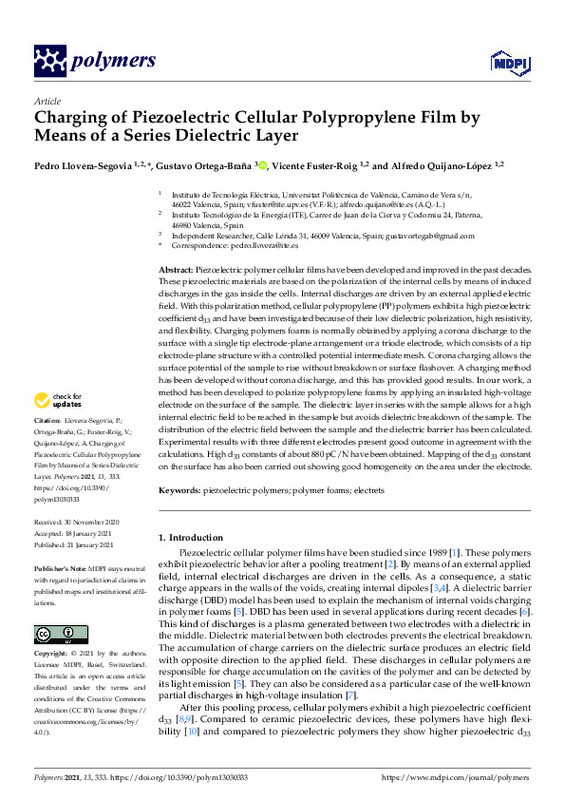JavaScript is disabled for your browser. Some features of this site may not work without it.
Buscar en RiuNet
Listar
Mi cuenta
Estadísticas
Ayuda RiuNet
Admin. UPV
Charging of Piezoelectric Cellular Polypropylene Film by Means of a Series Dielectric Layer
Mostrar el registro sencillo del ítem
Ficheros en el ítem
| dc.contributor.author | Llovera Segovia, Pedro
|
es_ES |
| dc.contributor.author | Ortega-Braña, Gustavo
|
es_ES |
| dc.contributor.author | Fuster Roig, Vicente Luis
|
es_ES |
| dc.contributor.author | Quijano-Lopez, Alfredo
|
es_ES |
| dc.date.accessioned | 2022-03-07T19:02:58Z | |
| dc.date.available | 2022-03-07T19:02:58Z | |
| dc.date.issued | 2021-02 | es_ES |
| dc.identifier.uri | http://hdl.handle.net/10251/181277 | |
| dc.description.abstract | [EN] Piezoelectric polymer cellular films have been developed and improved in the past decades. These piezoelectric materials are based on the polarization of the internal cells by means of induced discharges in the gas inside the cells. Internal discharges are driven by an external applied electric field. With this polarization method, cellular polypropylene (PP) polymers exhibit a high piezoelectric coefficient d(33) and have been investigated because of their low dielectric polarization, high resistivity, and flexibility. Charging polymers foams is normally obtained by applying a corona discharge to the surface with a single tip electrode-plane arrangement or a triode electrode, which consists of a tip electrode-plane structure with a controlled potential intermediate mesh. Corona charging allows the surface potential of the sample to rise without breakdown or surface flashover. A charging method has been developed without corona discharge, and this has provided good results. In our work, a method has been developed to polarize polypropylene foams by applying an insulated high-voltage electrode on the surface of the sample. The dielectric layer in series with the sample allows for a high internal electric field to be reached in the sample but avoids dielectric breakdown of the sample. The distribution of the electric field between the sample and the dielectric barrier has been calculated. Experimental results with three different electrodes present good outcome in agreement with the calculations. High d(33) constants of about 880 pC/N have been obtained. Mapping of the d(33) constant on the surface has also been carried out showing good homogeneity on the area under the electrode. | es_ES |
| dc.language | Inglés | es_ES |
| dc.publisher | MDPI AG | es_ES |
| dc.relation.ispartof | Polymers | es_ES |
| dc.rights | Reconocimiento (by) | es_ES |
| dc.subject | Piezoelectric polymers | es_ES |
| dc.subject | Polymer foams | es_ES |
| dc.subject | Electrets | es_ES |
| dc.subject.classification | INGENIERIA ELECTRICA | es_ES |
| dc.title | Charging of Piezoelectric Cellular Polypropylene Film by Means of a Series Dielectric Layer | es_ES |
| dc.type | Artículo | es_ES |
| dc.identifier.doi | 10.3390/polym13030333 | es_ES |
| dc.rights.accessRights | Abierto | es_ES |
| dc.contributor.affiliation | Universitat Politècnica de València. Instituto de Tecnología Eléctrica - Institut de Tecnologia Elèctrica | es_ES |
| dc.contributor.affiliation | Universitat Politècnica de València. Departamento de Ingeniería Eléctrica - Departament d'Enginyeria Elèctrica | es_ES |
| dc.description.bibliographicCitation | Llovera Segovia, P.; Ortega-Braña, G.; Fuster Roig, VL.; Quijano-Lopez, A. (2021). Charging of Piezoelectric Cellular Polypropylene Film by Means of a Series Dielectric Layer. Polymers. 13(3):1-12. https://doi.org/10.3390/polym13030333 | es_ES |
| dc.description.accrualMethod | S | es_ES |
| dc.relation.publisherversion | https://doi.org/10.3390/polym13030333 | es_ES |
| dc.description.upvformatpinicio | 1 | es_ES |
| dc.description.upvformatpfin | 12 | es_ES |
| dc.type.version | info:eu-repo/semantics/publishedVersion | es_ES |
| dc.description.volume | 13 | es_ES |
| dc.description.issue | 3 | es_ES |
| dc.identifier.eissn | 2073-4360 | es_ES |
| dc.identifier.pmid | 33494338 | es_ES |
| dc.identifier.pmcid | PMC7865647 | es_ES |
| dc.relation.pasarela | S\443497 | es_ES |
| upv.costeAPC | 1821 | es_ES |








